wheel Acura MDX 2015 Owner's Manual
[x] Cancel search | Manufacturer: ACURA, Model Year: 2015, Model line: MDX, Model: Acura MDX 2015Pages: 79, PDF Size: 16.44 MB
Page 56 of 79

104 || 105
DrIvING
DrIvING
Parking Sensor System*
When the system senses an object when you are parking or backing up, an indicator appears
on the upper display and a series of beeps will sound. As you get closer to the object, the
beep rate increases.
Turning the System on or off
Press the parking sensor button. A green indicator light
appears on the button when the system is on.
Indicators appear when the
sensor device detects an
obstacle.
*if equipped
Indicator
multi- view r ear Camera
When you shift into Reverse (R), a real-time image of the area behind your vehicle is shown
in the display, along with helpful parking guidelines.
The rear camera view is restricted. You cannot see the corner ends of the bumper or what is underneath the
bumper. Its unique lens also makes objects appear closer or farther than they actually are.
Visually confirm that it is safe to drive before backing up. Certain conditions (such as weather, lighting, and high
temperatures) may also restrict the rear view. Do not rely on the rearview display, which does not give you all
information about conditions at the rear of your vehicle.
Wide view Normal view Top down view
Press the
interface dial
to toggle
between
views.
Changing Guidelines
Turn the guidelines on or off. Use the interface dial to make and enter selections.
1. Press SETTINGS.
2. Select Camera Settings
3. Select one of the options.
Fixed Guidelines: Guidelines appear when you shift into
Reverse. Select On or Off.
Dynamic Guidelines: Guidelines move as you turn the
steering wheel. Select On or Off.
4. Press BACK to exit the menu.
Page 59 of 79
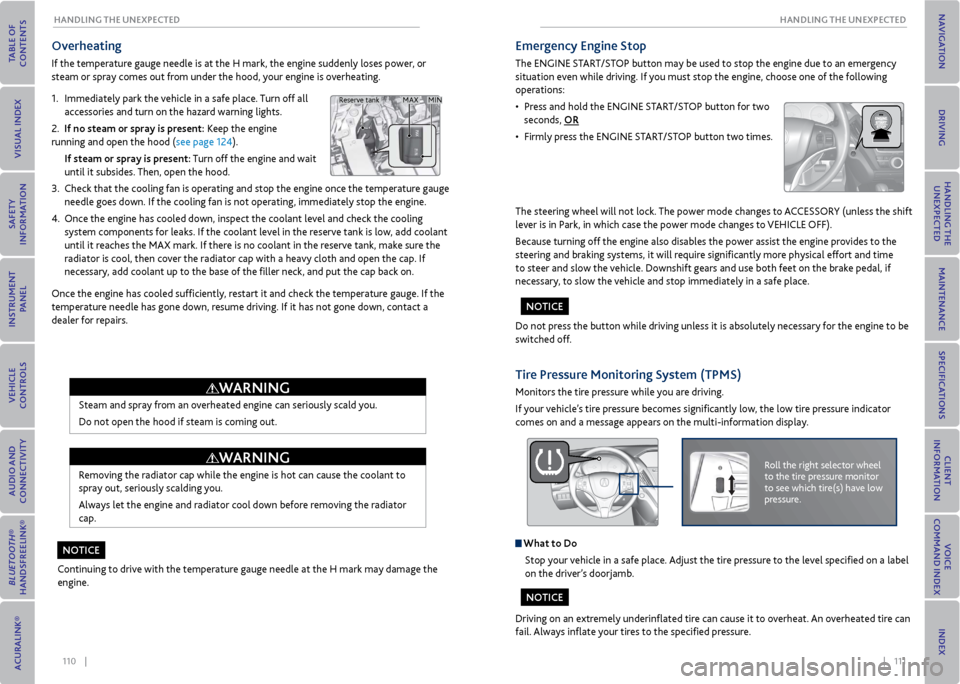
110 || 111
HANDLING THe UNexPeCTeD
HANDLING THe UNexPeCTeD
overheating
If the temperature gauge needle is at the H mark, the engine suddenly loses power, or
steam or spray comes out from under the hood, your engine is overheating.
1. Immediately park the vehicle in a safe place. Turn off all
accessories and turn on the hazard warning lights.
2. If no steam or spray is present: Keep the engine
running and open the hood (see page 124).
If steam or spray is present: Turn off the engine and wait
until it subsides. Then, open the hood.
3. Check that the cooling fan is operating and stop the engine once the temperature gauge
needle goes down. If the cooling fan is not operating, immediately stop the engine.
4. Once the engine has cooled down, inspect the coolant level and check the cooling
system components for leaks. If the coolant level in the reserve tank is low, add coolant
until it reaches the MAX mark. If there is no coolant in the reserve tank, make sure the
radiator is cool, then cover the radiator cap with a heavy cloth and open the cap. If
necessary, add coolant up to the base of the filler neck, and put the cap back on.
Once the engine has cooled sufficiently, restart it and check the temperature gauge. If the
temperature needle has gone down, resume driving. If it has not gone down, contact a
dealer for repairs.
Steam and spray from an overheated engine can seriously scald you.
Do not open the hood if steam is coming out.
Removing the radiator cap while the engine is hot can cause the coolant to
spray out, seriously scalding you.
Always let the engine and radiator cool down before removing the radiator
cap.
Continuing to drive with the temperature gauge needle at the H mark may damage the
engine.
MAX MIN
Reserve tank
WArNING
WArNING
No TICe
emergency engine Stop
The ENGINE START/STOP button may be used to stop the engine due to an emergency
situation even while driving. If you must stop the engine, choose one of the following
operations:
• Press and hold the ENGINE START/STOP button for two
seconds, or
• Firmly press the ENGINE START/STOP button two times.
The steering wheel will not lock. The power mode changes to ACCESSORY (unless the shift
lever is in Park, in which case the power mode changes to VEHICLE OFF).
Because turning off the engine also disables the power assist the engine provides to the
steering and braking systems, it will require significantly more physical effort and time
to steer and slow the vehicle. Downshift gears and use both feet on the brake pedal, if
necessary, to slow the vehicle and stop immediately in a safe place.
Do not press the button while driving unless it is absolutely necessary for the engine to be
switched off.
Tire Pressure monitoring System (TPmS)
Monitors the tire pressure while you are driving.
If your vehicle’s tire pressure becomes significantly low, the low tire pressure indicator
comes on and a message appears on the multi-information display.
Roll the right selector wheel
to the tire pressure monitor
to see which tire(s) have low
pressure.
What to Do Stop your vehicle in a safe place. Adjust the tire pressure to the level specified on a label
on the driver’s doorjamb.
Driving on an extremely underinflated tire can cause it to overheat. An overheated tire can
fail. Always inflate your tires to the specified pressure.
No TICe
NoTICe
Page 60 of 79
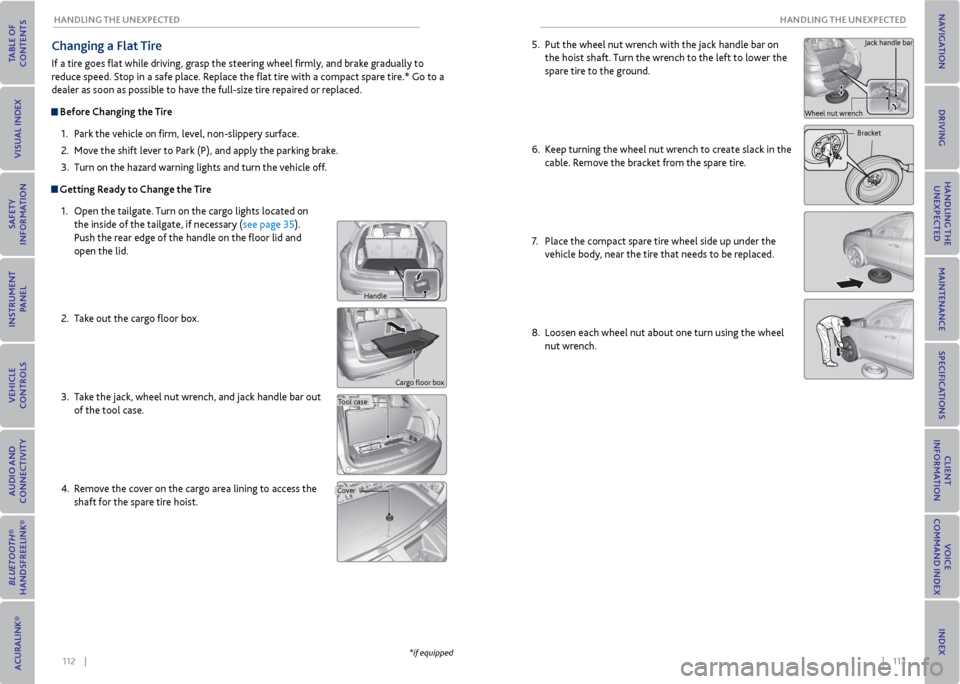
112 || 113
HANDLING THe UNexPeCTeD
HANDLING THe UNexPeCTeD
Changing a Flat Tire
If a tire goes flat while driving, grasp the steering wheel firmly, and brake gradually to
reduce speed. Stop in a safe place. Replace the flat tire with a compact spare tire.* Go to a
dealer as soon as possible to have the full-size tire repaired or replaced.
Before Changing the Tire
1. Park the vehicle on firm, level, non-slippery surface.
2. Move the shift lever to Park (P), and apply the parking brake.
3. Turn on the hazard warning lights and turn the vehicle off.
Getting ready to Change the Tire
1. Open the tailgate. Turn on the cargo lights located on
the inside of the tailgate, if necessary (see page 35).
Push the rear edge of the handle on the floor lid and
open the lid.
2. Take out the cargo floor box.
3. Take the jack, wheel nut wrench, and jack handle bar out
of the tool case.
4. Remove the cover on the cargo area lining to access the
shaft for the spare tire hoist.
Cargo floor box
Tool case
Cover
*if equipped
5. Put the wheel nut wrench with the jack handle bar on
the hoist shaft. Turn the wrench to the left to lower the
spare tire to the ground.
6. Keep turning the wheel nut wrench to create slack in the
cable. Remove the bracket from the spare tire.
7. Place the compact spare tire wheel side up under the
vehicle body, near the tire that needs to be replaced.
8. Loosen each wheel nut about one turn using the wheel
nut wrench.
Bracket
Wheel nut wrench Jack handle bar
Handle
Page 61 of 79
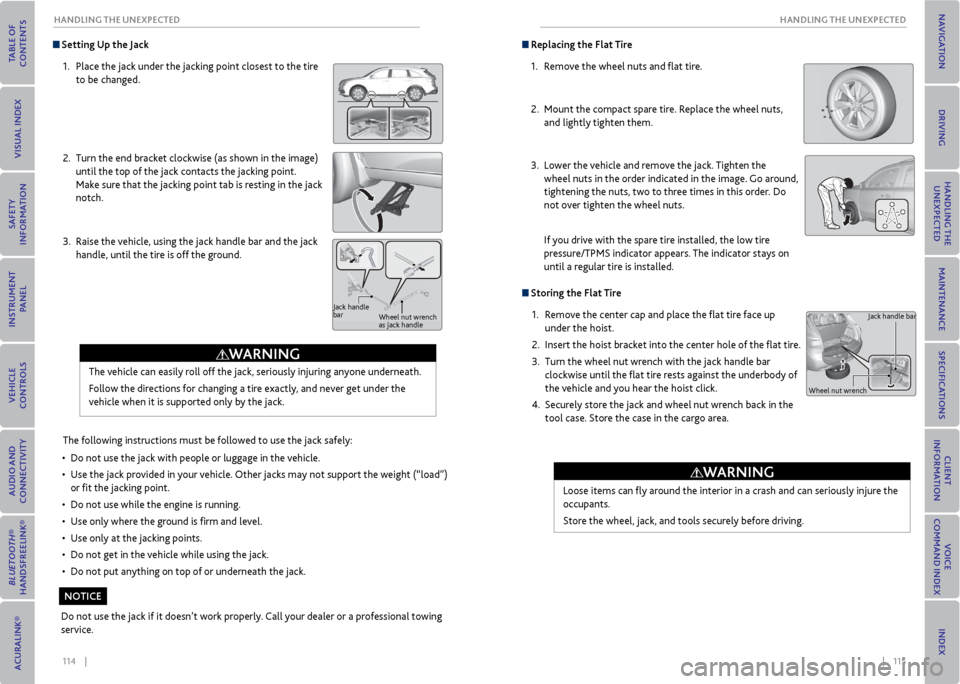
114 || 115
HANDLING THe UNexPeCTeD
HANDLING THe UNexPeCTeD
Setting Up the Jack
1. Place the jack under the jacking point closest to the tire
to be changed.
2. Turn the end bracket clockwise (as shown in the image)
until the top of the jack contacts the jacking point.
Make sure that the jacking point tab is resting in the jack
notch.
3. Raise the vehicle, using the jack handle bar and the jack
handle, until the tire is off the ground.
The following instructions must be followed to use the jack safely:
• Do not use the jack with people or luggage in the vehicle.
• Use the jack provided in your vehicle. Other jacks may not support the weight (“load”)
or fit the jacking point.
• Do not use while the engine is running.
• Use only where the ground is firm and level.
• Use only at the jacking points.
• Do not get in the vehicle while using the jack.
• Do not put anything on top of or underneath the jack.
The vehicle can easily roll off the jack, seriously injuring anyone underneath.
Follow the directions for changing a tire exactly, and never get under the
vehicle when it is supported only by the jack.
Jack handle
bar
Wheel nut wrench
as jack handle
Do not use the jack if it doesn’t work properly. Call your dealer or a professional towing
service.
WArNING
NoTICe
replacing the Flat Tire
1. Remove the wheel nuts and flat tire.
2. Mount the compact spare tire. Replace the wheel nuts,
and lightly tighten them.
3. Lower the vehicle and remove the jack. Tighten the
wheel nuts in the order indicated in the image. Go around,
tightening the nuts, two to three times in this order. Do
not over tighten the wheel nuts.
If you drive with the spare tire installed, the low tire
pressure/TPMS indicator appears. The indicator stays on
until a regular tire is installed.
Storing the Flat Tire
1. Remove the center cap and place the flat tire face up
under the hoist.
2. Insert the hoist bracket into the center hole of the flat tire.
3. Turn the wheel nut wrench with the jack handle bar
clockwise until the flat tire rests against the underbody of
the vehicle and you hear the hoist click.
4. Securely store the jack and wheel nut wrench back in the
tool case. Store the case in the cargo area.
Loose items can fly around the interior in a crash and can seriously injure the
occupants.
Store the wheel, jack, and tools securely before driving.
Jack handle bar
Wheel nut wrench
WArNING
Page 64 of 79
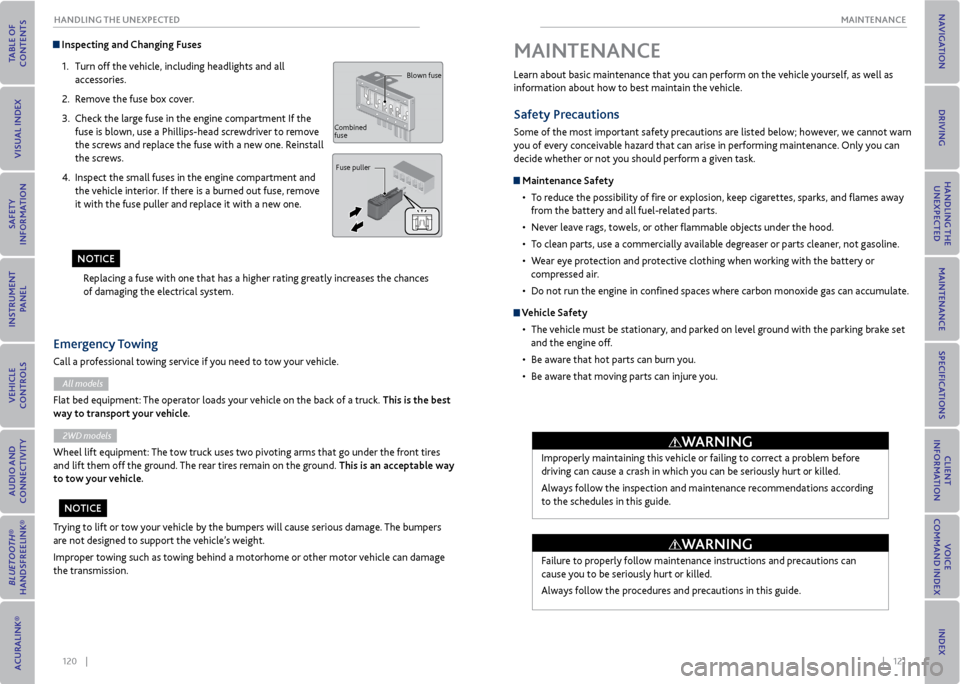
120 || 121
mAINTeNANCe
HANDLING THe UNexPeCTeD
Inspecting and Changing Fuses
1. Turn off the vehicle, including headlights and all
accessories.
2. Remove the fuse box cover.
3. Check the large fuse in the engine compartment If the
fuse is blown, use a Phillips-head screwdriver to remove
the screws and replace the fuse with a new one. Reinstall
the screws.
4. Inspect the small fuses in the engine compartment and
the vehicle interior. If there is a burned out fuse, remove
it with the fuse puller and replace it with a new one.
Replacing a fuse with one that has a higher rating greatly increases the chances
of damaging the electrical system.
Blown fuse
Combined
fuse Fuse puller
Trying to lift or tow your vehicle by the bumpers will cause serious damage. The bumpers
are not designed to support the vehicle’s weight.
Improper towing such as towing behind a motorhome or other motor vehicle can damage
the transmission.
emergency Towing
Call a professional towing service if you need to tow your vehicle.
All models
Flat bed equipment: The operator loads your vehicle on the back of a truck. This is the best
way to transport your vehicle.
2WD models
Wheel lift equipment: The tow truck uses two pivoting arms that go under the front tires
and lift them off the ground. The rear tires remain on the ground. This is an acceptable way
to tow your vehicle.
No TICe
NoTICe Learn about basic maintenance that you can perform on the vehicle yourself, as well as
information about how to best maintain the vehicle.
Safety Precautions
Some of the most important safety precautions are listed below; however, we cannot warn
you of every conceivable hazard that can arise in performing maintenance. Only you can
decide whether or not you should perform a given task.
maintenance Safety
• To reduce the possibility of fire or explosion, keep cigarettes, sparks, and flames away
from the battery and all fuel-related parts.
• Never leave rags, towels, or other flammable objects under the hood.
• To clean parts, use a commercially available degreaser or parts cleaner, not gasoline.
• Wear eye protection and protective clothing when working with the battery or
compressed air.
• Do not run the engine in confined spaces where carbon monoxide gas can accumulate.
vehicle Safety
• The vehicle must be stationary, and parked on level ground with the parking brake set
and the engine off.
• Be aware that hot parts can burn you.
• Be aware that moving parts can injure you.
mAINTeNANCe
Improperly maintaining this vehicle or failing to correct a problem before
driving can cause a crash in which you can be seriously hurt or killed.
Always follow the inspection and maintenance recommendations according
to the schedules in this guide.
Failure to properly follow maintenance instructions and precautions can
cause you to be seriously hurt or killed.
Always follow the procedures and precautions in this guide.
WArNING
WArNING
Page 65 of 79
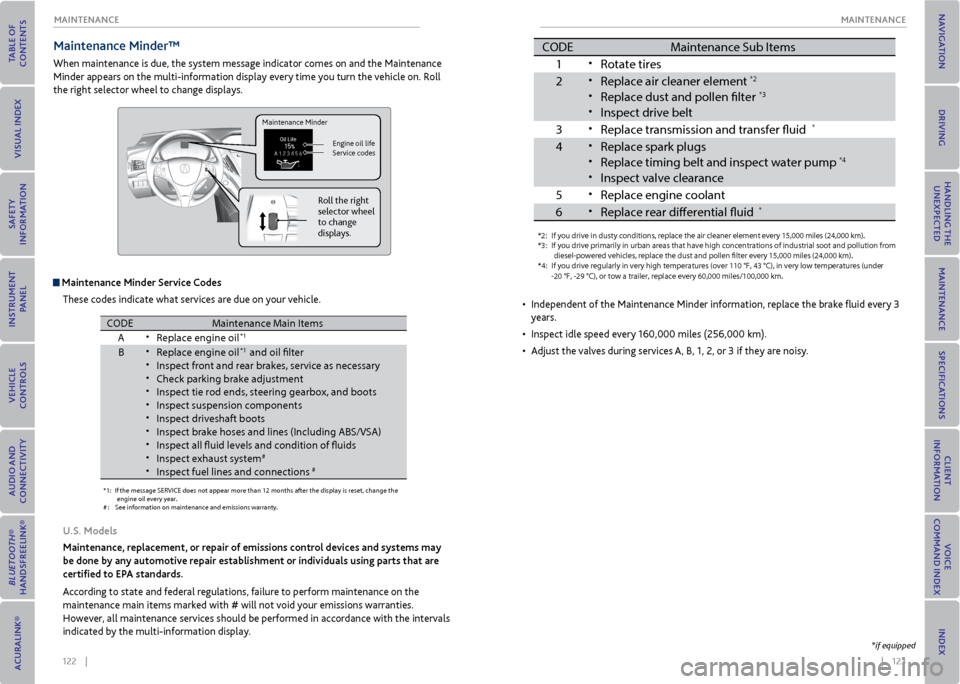
122 || 123
mAINTeNANCe
mAINTeNANCe
maintenance minder™
When maintenance is due, the system message indicator comes on and the Maintenance
Minder appears on the multi-information display every time you turn the vehicle on. Roll
the right selector wheel to change displays.
maintenance minder Service Codes
These codes indicate what services are due on your vehicle.
*1: If the message SERVICE does not appear more than 12 months after the display is\
reset, change the
engine oil every year .
#: See information on maintenance and emissions warranty.
CODEMaintenance Main Items
A
•Replace engine oi l*1
B•Replace engine oil*1 and oil flter•Inspect front and rear brakes, service as necessar y•Check parking brake adjustment•Inspect tie rod ends, steering gearbox, and boot s•Inspect suspension components•Inspect driveshaft boots•Inspect brake hoses and lines (Including ABS/VSA)•Inspect all fuid levels and condition of fuid s•Inspect exhaust system#
•Inspect fuel lines and connections#
*4:If you drive regularly in very high temperatures (over 110 °F, 43 °\
C), in very low temperatures (unde r
-20 °F, -29 °C), or tow a trai ler, repl ace ever y 60,000 mi les/100,000 km .
CODE Maintenance Sub Items
1
•Rotate tires
2
•Replace air cleaner element*2
•Replace dust and pollen flte r*3
•Inspect drive belt
3
•Replace transmission and transfer fuid*
4•Replace spark plug s•Replace timing belt an d inspect water pump*4
•Inspect valve clearanc
e
5
•Replace engine coolan t
6
•Replace rear diferential fuid*
*2:I f you drive in dusty condi tion s, replac e the air cleaner element every 15,000 miles (24,000 km).
*3: If you drive primarily in urban areas that have high concentrations of i\
ndustrial soot and pollution from
diesel-powered vehicles, replace the dust and pollen flter every 15,000 miles (24,000 km).
U.S. models
maintenance, replacement, or repair of emissions control devices and systems may
be done by any automotive repair establishment or individuals using parts that are
certified to ePA standards.
According to state and federal regulations, failure to perform maintenance on the
maintenance main items marked with # will not void your emissions warranties.
However, all maintenance services should be performed in accordance with the intervals
indicated by the multi-information display.
Maintenance Minder
Engine oil life
Service codes
Roll the right
selector wheel
to change
displays.
*1: If the message SERVICE does not appear more than 12 months after the display is\
reset, change the
engine oil every year .
#: See information on maintenance and emissions warranty.
CODEMaintenance Main Item s
A
•Replace engine oi l*1
B•Replace engine oil*1 and oil flter
•Inspect front and rear brakes, service as necessar y
•Check parking brake adjustment
•Inspect tie rod ends, steering gearbox, and boot s
•Inspect suspension components
•Inspect driveshaft boots
•Inspect brake hoses and lines (Including ABS/VSA)
•Inspect all fuid levels and condition of fuid s
•Inspect exhaust system#
•Inspect fuel lines and connections#
*4:If you drive regularly in very high temperatures (over 110 °F, 43 °\
C), in very low temperatures (unde r
-20 °F, -29 °C), or tow a trai ler, repl ace ever y 60,000 mi les/100,000 km .
CODEMaintenance Sub Item s
1
•Rotate tires
2•Replace air cleaner element*2
•Replace dust and pollen flte r*3
•Inspect drive belt
3
•Replace transmission and transfer fuid*
4•Replace spark plug s
•Replace timing belt an d inspect water pump*4
•Inspect valve clearanc
e
5
•Replace engine coolan t
6•Replace rear diferential fuid*
*2:If you drive in dusty condi tion s, replac e the air cleaner element every 15,000 miles (24,000 km).
*3: If you drive primarily in urban areas that have high concentrations of i\
ndustrial soot and pollution from
diesel-powered vehicles, replace the dust and pollen flter every 15,000 miles (24,000 km).
• Independent of the Maintenance Minder information, replace the brake fluid every 3
years.
• Inspect idle speed every 160,000 miles (256,000 km).
• Adjust the valves during services A, B, 1, 2, or 3 if they are noisy.
*if equipped
Page 67 of 79
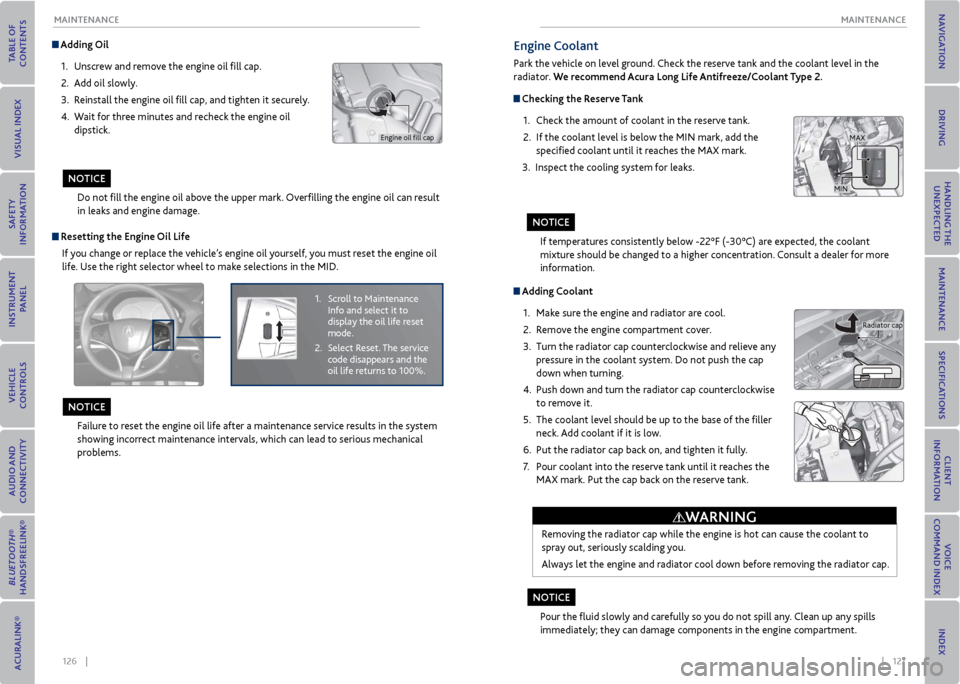
126 || 127
mAINTeNANCe
mAINTeNANCe
Adding oil
1. Unscrew and remove the engine oil fill cap.
2. Add oil slowly.
3. Reinstall the engine oil fill cap, and tighten it securely.
4. Wait for three minutes and recheck the engine oil
dipstick.
Do not fill the engine oil above the upper mark. Overfilling the engine oil can result
in leaks and engine damage.
Engine oil fill cap
r esetting the engine oil Life
If you change or replace the vehicle’s engine oil yourself, you must reset the engine oil
life. Use the right selector wheel to make selections in the MID.
Failure to reset the engine oil life after a maintenance service results in the system
showing incorrect maintenance intervals, which can lead to serious mechanical
problems.
1. Scroll to Maintenance
Info and select it to
display the oil life reset
mode.
2. Select Reset. The service
code disappears and the
oil life returns to 100%.
No TICe
NoTICe
Adding Coolant
1. Make sure the engine and radiator are cool.
2. Remove the engine compartment cover.
3. Turn the radiator cap counterclockwise and relieve any
pressure in the coolant system. Do not push the cap
down when turning.
4. Push down and turn the radiator cap counterclockwise
to remove it.
5. The coolant level should be up to the base of the filler
neck. Add coolant if it is low.
6. Put the radiator cap back on, and tighten it fully.
7. Pour coolant into the reserve tank until it reaches the
MAX mark. Put the cap back on the reserve tank.
Removing the radiator cap while the engine is hot can cause the coolant to
spray out, seriously scalding you.
Always let the engine and radiator cool down before removing the radiator cap.
Pour the fluid slowly and carefully so you do not spill any. Clean up any spills
immediately; they can damage components in the engine compartment.
Radiator cap
WArNING
engine Coolant
Park the vehicle on level ground. Check the reserve tank and the coolant level in the
radiator. We recommend Acura Long Life Antifreeze/Coolant Type 2.
Checking the reserve Tank
1. Check the amount of coolant in the reserve tank.
2. If the coolant level is below the MIN mark, add the
specified coolant until it reaches the MAX mark.
3. Inspect the cooling system for leaks.
If temperatures consistently below -22°F (-30°C) are expected, the coolant
mixture should be changed to a higher concentration. Consult a dealer for more
information.
MAX
MIN
No TICe
NoTICe
Page 69 of 79
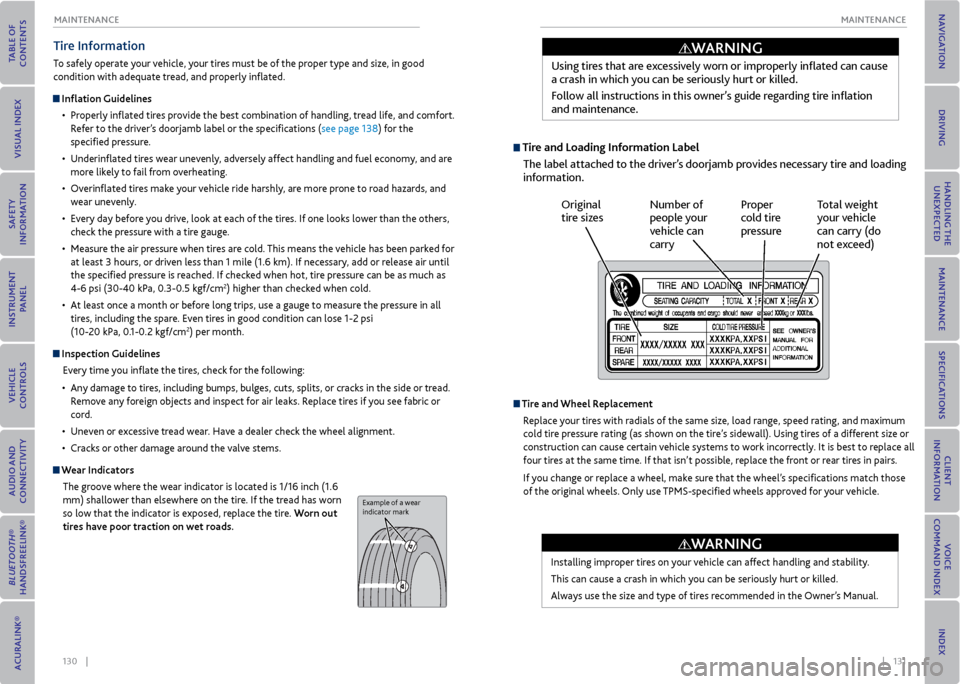
130 || 131
mAINTeNANCe
mAINTeNANCe
Tire Information
To safely operate your vehicle, your tires must be of the proper type and size, in good
condition with adequate tread, and properly inflated.
Inflation Guidelines
• Properly inflated tires provide the best combination of handling, tread life, and comfort.
Refer to the driver’s doorjamb label or the specifications (see page 138) for the
specified pressure.
• Underinflated tires wear unevenly, adversely affect handling and fuel economy, and are
more likely to fail from overheating.
• Overinflated tires make your vehicle ride harshly, are more prone to road hazards, and
wear unevenly.
• Every day before you drive, look at each of the tires. If one looks lower than the others,
check the pressure with a tire gauge.
• Measure the air pressure when tires are cold. This means the vehicle has been parked for
at least 3 hours, or driven less than 1 mile (1.6 km). If necessary, add or release air until
the specified pressure is reached. If checked when hot, tire pressure can be as much as
4-6 psi (30-40 kPa, 0.3-0.5 kgf/cm
2) higher than checked when cold.
• At least once a month or before long trips, use a gauge to measure the pressure in all
tires, including the spare. Even tires in good condition can lose 1-2 psi
(10-20 kPa, 0.1-0.2 kgf/cm
2) per month.
Inspection Guidelines
Every time you inflate the tires, check for the following:
• Any damage to tires, including bumps, bulges, cuts, splits, or cracks in the side or tread.
Remove any foreign objects and inspect for air leaks. Replace tires if you see fabric or
cord.
• Uneven or excessive tread wear. Have a dealer check the wheel alignment.
• Cracks or other damage around the valve stems.
Wear Indicators
The groove where the wear indicator is located is 1/16 inch (1.6
mm) shallower than elsewhere on the tire. If the tread has worn
so low that the indicator is exposed, replace the tire. Worn out
tires have poor traction on wet roads.
Example of a wear
indicator mark
Tire and Loading Information LabelThe label attached to the driver’s doorjamb provides necessary tire and loading
information. Using tires that are excessively worn or improperly inflated can cause
a crash in which you can be seriously hurt or killed.
Follow all instructions in this owner’s guide regarding tire inflation
and maintenance.
Original
tire sizes
Number of
people your
vehicle can
carry Proper
cold tire
pressure
Total weight
your vehicle
can carry (do
not exceed)
Tire and Wheel r eplacement
Replace your tires with radials of the same size, load range, speed rating, and maximum
cold tire pressure rating (as shown on the tire’s sidewall). Using tires of a different size or
construction can cause certain vehicle systems to work incorrectly. It is best to replace all
four tires at the same time. If that isn’t possible, replace the front or rear tires in pairs.
If you change or replace a wheel, make sure that the wheel’s specifications match those
of the original wheels. Only use TPMS-specified wheels approved for your vehicle.
Installing improper tires on your vehicle can affect handling and stability.
This can cause a crash in which you can be seriously hurt or killed.
Always use the size and type of tires recommended in the Owner’s Manual.
WArNING
WArNING
Page 70 of 79
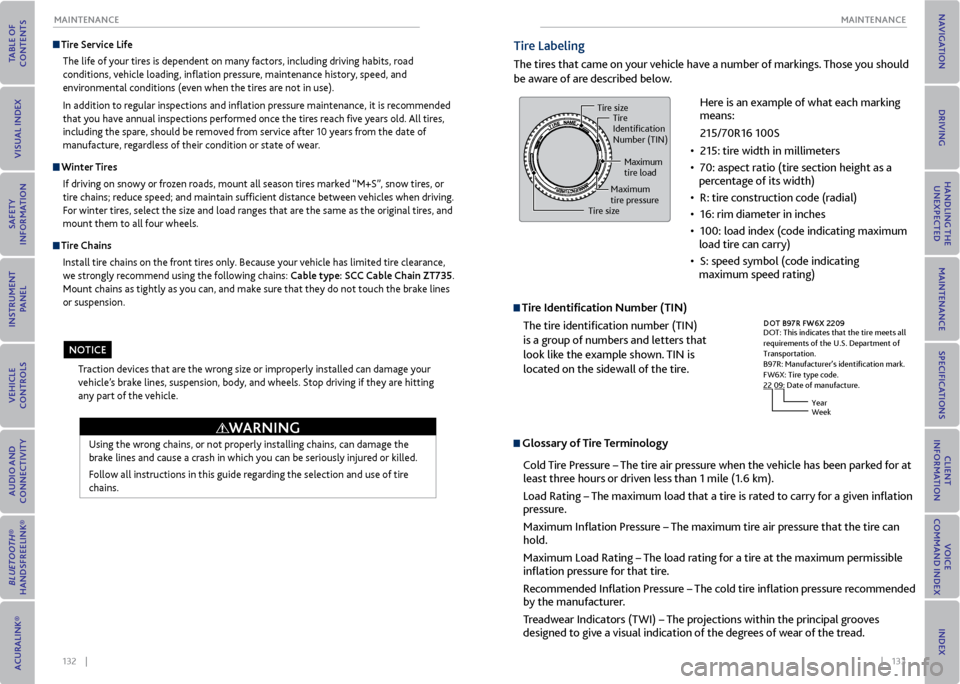
132 || 133
mAINTeNANCe
mAINTeNANCe
Tire Service Life
The life of your tires is dependent on many factors, including driving habits, road
conditions, vehicle loading, inflation pressure, maintenance history, speed, and
environmental conditions (even when the tires are not in use).
In addition to regular inspections and inflation pressure maintenance, it is recommended
that you have annual inspections performed once the tires reach five years old. All tires,
including the spare, should be removed from service after 10 years from the date of
manufacture, regardless of their condition or state of wear.
Winter Tires
If driving on snowy or frozen roads, mount all season tires marked “M+S”, snow tires, or
tire chains; reduce speed; and maintain sufficient distance between vehicles when driving.
For winter tires, select the size and load ranges that are the same as the original tires, and
mount them to all four wheels.
Tire Chains
Install tire chains on the front tires only. Because your vehicle has limited tire clearance,
we strongly recommend using the following chains: Cable type: SCC Cable Chain ZT735.
Mount chains as tightly as you can, and make sure that they do not touch the brake lines
or suspension.
Using the wrong chains, or not properly installing chains, can damage the
brake lines and cause a crash in which you can be seriously injured or killed.
Follow all instructions in this guide regarding the selection and use of tire
chains.
Traction devices that are the wrong size or improperly installed can damage your
vehicle’s brake lines, suspension, body, and wheels. Stop driving if they are hitting
any part of the vehicle.
WArNING
NoTICe
Tire Labeling
The tires that came on your vehicle have a number of markings. Those you should
be aware of are described below.
Tire Identification Number (TIN)
The tire identification number (TIN)
is a group of numbers and letters that
look like the example shown. TIN is
located on the sidewall of the tire.
Glossary of Tire Terminology
Cold Tire Pressure – The tire air pressure when the vehicle has been parked for at
least three hours or driven less than 1 mile (1.6 km).
Load Rating – The maximum load that a tire is rated to carry for a given inflation
pressure.
Maximum Inflation Pressure – The maximum tire air pressure that the tire can
hold.
Maximum Load Rating – The load rating for a tire at the maximum permissible
inflation pressure for that tire.
Recommended Inflation Pressure – The cold tire inflation pressure recommended
by the manufacturer.
Treadwear Indicators (TWI) – The projections within the principal grooves
designed to give a visual indication of the degrees of wear of the tread.
DO T B97R FW6X 2209
DOT: This indicates that the tire meets all
requirements of the
U.S. Department of Transportation.
B97R: Manufacturer’s identi�cation mark.
FW6X: Tire type code.
22 09: Date of manufacture.
YearWeek
Here is an example of what each marking
means:
215/70R16 100S
• 215: tire width in millimeters
• 70: aspect ratio (tire section height as a
percentage of its width)
• R: tire construction code (radial)
• 16: rim diameter in inches
• 100: load index (code indicating maximum
load tire can carry)
• S: speed symbol (code indicating
maximum speed rating)Tire size Tire
Identi�cation
Number (TIN)
Maximum
tire load
Maximum
tire pressure
Tire size
Page 71 of 79
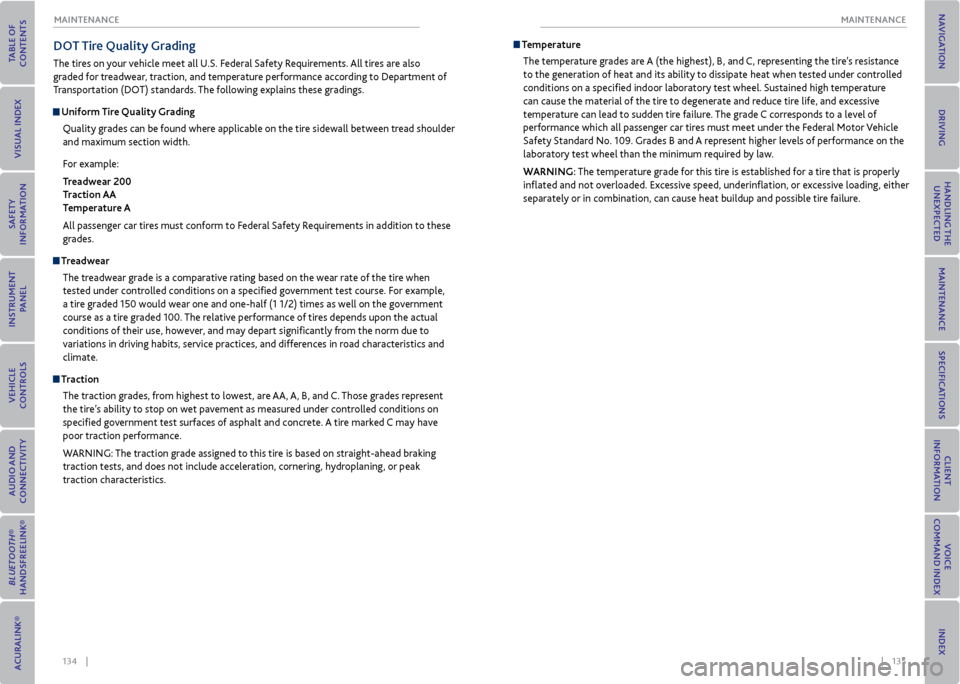
134 || 135
mAINTeNANCe
mAINTeNANCe
Do T Tire Quality Grading
The tires on your vehicle meet all U.S. Federal Safety Requirements. All tires are also
graded for treadwear, traction, and temperature performance according to Department of
Transportation (DOT) standards. The following explains these gradings.
Uniform Tire Quality Grading
Quality grades can be found where applicable on the tire sidewall between tread shoulder
and maximum section width.
For example:
Treadwear 200
Traction AA
Temperature A
All passenger car tires must conform to Federal Safety Requirements in addition to these
grades.
TreadwearThe treadwear grade is a comparative rating based on the wear rate of the tire when
tested under controlled conditions on a specified government test course. For example,
a tire graded 150 would wear one and one-half (1 1/2) times as well on the government
course as a tire graded 100. The relative performance of tires depends upon the actual
conditions of their use, however, and may depart significantly from the norm due to
variations in driving habits, service practices, and differences in road characteristics and
climate.
TractionThe traction grades, from highest to lowest, are AA, A, B, and C. Those grades represent
the tire’s ability to stop on wet pavement as measured under controlled conditions on
specified government test surfaces of asphalt and concrete. A tire marked C may have
poor traction performance.
WARNING: The traction grade assigned to this tire is based on straight-ahead braking
traction tests, and does not include acceleration, cornering, hydroplaning, or peak
traction characteristics.
TemperatureThe temperature grades are A (the highest), B, and C, representing the tire’s resistance
to the generation of heat and its ability to dissipate heat when tested under controlled
conditions on a specified indoor laboratory test wheel. Sustained high temperature
can cause the material of the tire to degenerate and reduce tire life, and excessive
temperature can lead to sudden tire failure. The grade C corresponds to a level of
performance which all passenger car tires must meet under the Federal Motor Vehicle
Safety Standard No. 109. Grades B and A represent higher levels of performance on the
laboratory test wheel than the minimum required by law.
WArNING: The temperature grade for this tire is established for a tire that is properly
inflated and not overloaded. Excessive speed, underinflation, or excessive loading, either
separately or in combination, can cause heat buildup and possible tire failure.